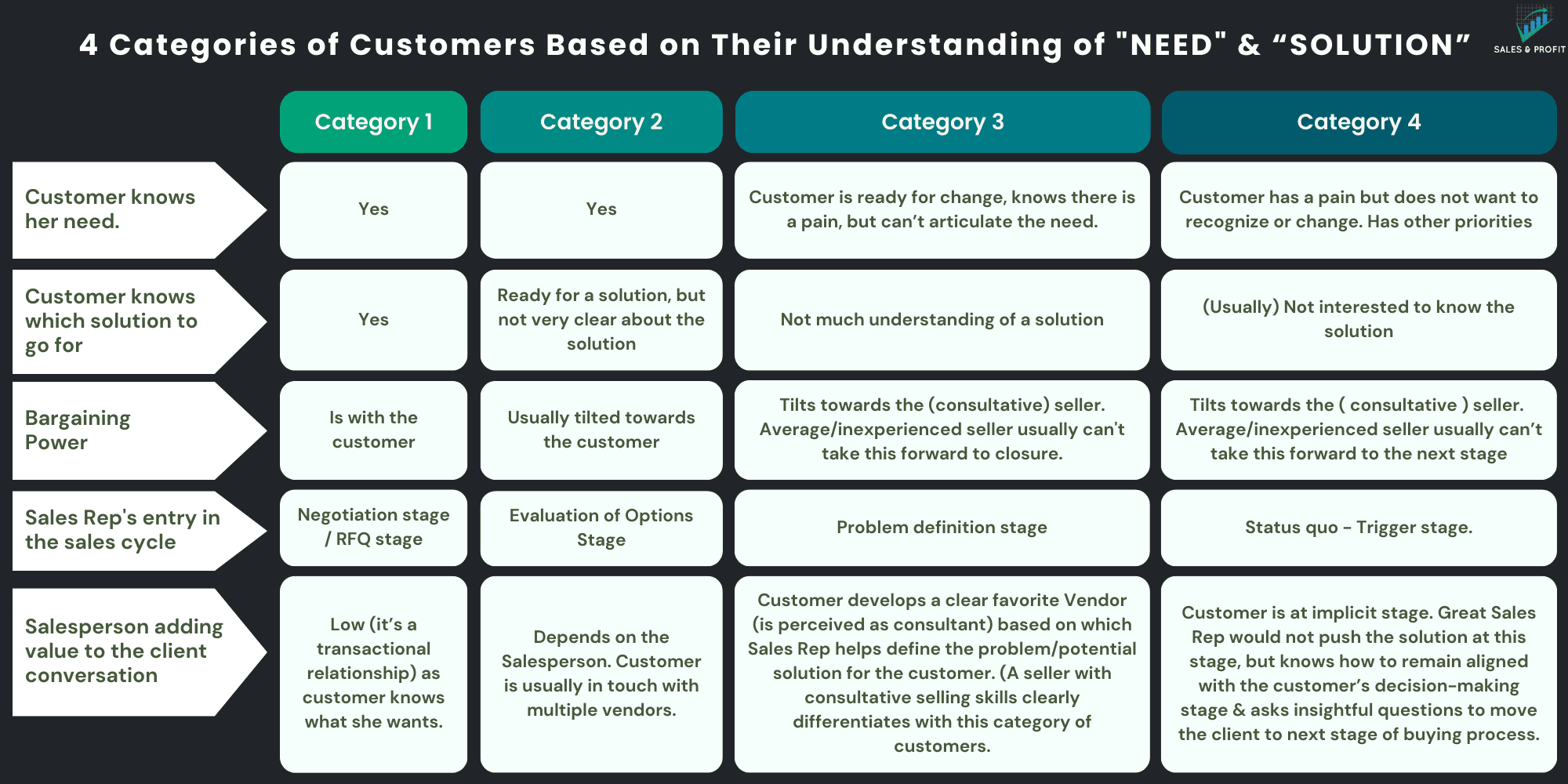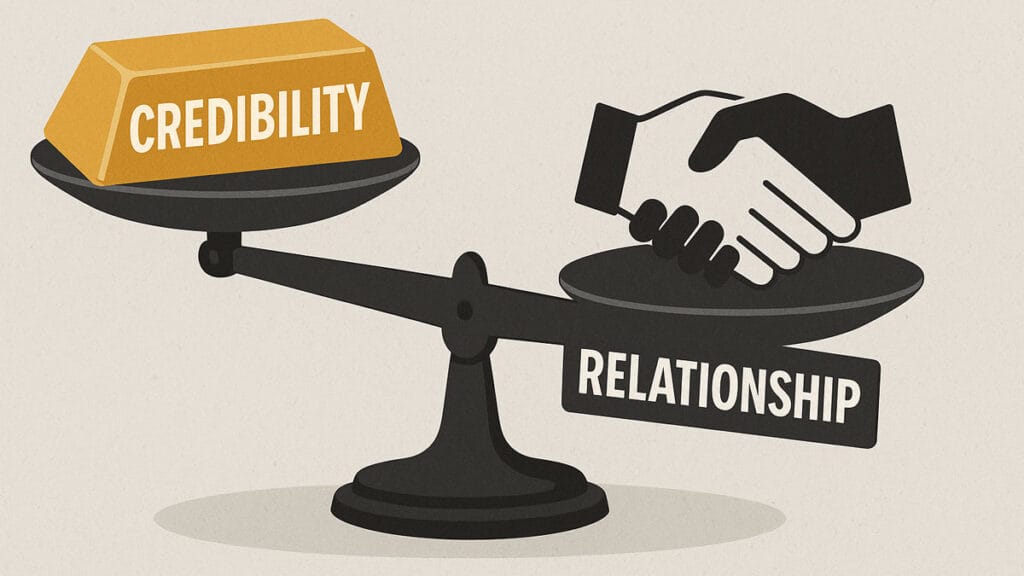What’s the biggest mistakes B2B sales professionals can make?
It’s selling the same way to every customer.
It’s like playing the same cricket shot – stepping onto the front foot for every delivery – without considering the bowler, pitch conditions, or the ground.
But, a few years ago, I had a eureka moment.
I realized that customers can be divided into 4 categories based on their own understanding of “NEED” and “SOLUTION”.
So with my experience of working with multiple clients and discussions with sales reps/leaders during our enterprise sales training programs, I have tried to segregate prospective B2B customers into 4 categories based on customers’ understanding of their “NEED’ and awareness about the “SOLUTION”.
Below, I have tried to explain each category of customers, dividing each into 5 points –
- Need Awareness
- Solution Knowledge
- Bargaining Power
- Sales Rep’s Entry in the Sales Cycle
- Value Addition by the Sales Rep
Category 1 Customers
Let me break this down in detail for you.
Their Need Awareness
These customers are crystal clear about their needs.
They’ve done their homework.
They know exactly what problem they’re trying to solve.
There’s zero confusion in their mind about what they want.
Their Solution Knowledge
They don’t just know their problem.
They’ve already decided on the solution they want.
It’s like they’ve written their own prescription.
They come to the sales rep saying, “This is exactly what I need.”
Who Has the Bargaining Power?
In Category 1, the customer holds the bargaining power.
Why?
Because they know exactly what they want.
They’re probably talking to multiple vendors.
They’re comparing prices.
They’re comparing one supplier against another.
It’s like going to different pharmacies with the same prescription, looking for the best price.
Sales Rep's Entry in the Sales Cycle
When do sales reps enter the sales cycle for category 1 customers?
Usually at the very end of the sales cycle.
They’re usually entering the negotiation stage or RFQ stage.
Sometimes even at the proposal stage.
The customer has already made most of their decisions.
What Value Does Sales Rep Add to the Customer?
Sales rep’s value addition is quite limited here.
They are basically an order taker.
The relationship stays transactional.
What differentiators do customers usually see :
- Price
- Discounts
- Delivery time
- Speed
Here price plays the most important role because the customer would be comparing your price with multiple vendors.
Category 2 Customers
Let me break this down in detail for you.
Their Need Awareness
These customers are interesting.
They know what their problem is.
They can articulate their need clearly.
They understand their pain points perfectly.
Their Solution Knowledge
They’re not entirely sure about the solution.
They have some ideas, but there’s ambiguity.
They’re open to exploring different options.
They’re looking for guidance on what might work best.
Think of it like someone who knows they have a health issue but isn’t sure which treatment to go for.
Who Has the Bargaining Power?
The bargaining power usually tilts toward the customer.
Why?
Because they’re actively exploring multiple options.
They’re talking to different vendors.
They’re comparing different solutions.
Sales Rep's Entry in the Sales Cycle
Sales reps meet these customers at the evaluation stage.
They’re actively comparing options.
They’re looking at different approaches.
They’re trying to understand what might work best for them.
This is where you can make a real difference.
What Value Does Sales Rep Add to the Customer?
Here’s where it gets interesting
Your value potential depends entirely on your approach.
If you’re an average seller:
- You’ll just respond to their stated needs
- You’ll simply answer their questions
- You’ll basically be responding to an RFP
But if you’re a consultative seller:
- You can help them evaluate options
- You can bring new perspectives
- You can guide their decision-making process
- You can add significant value through expertise
Who Has the Bargaining Power?
Category 3 Customers
This is the most interesting category of customers
Their Need Awareness
Here’s what makes Category 3 unique:
They can’t clearly articulate their needs.
But – they’re ready for change.
There’s either pain in their world.
Or there’s an aspiration they want to achieve.
They know something needs to change.
But they struggle to understand what exactly they need.
Their Solution Knowledge
Naturally, if they can’t define their need clearly – They have a very limited understanding of potential solutions.
They might have vague ideas.
But they’re not sure what would actually work.
They need help defining a solution for themselves.
Who Has the Bargaining Power?
The bargaining power can actually tilt towards the seller.
But there’s a big “IF” here:
It only works if you’re a consultative seller.
If you’re just an average salesperson:
- You’ll struggle to take the conversation forward
- You might complain that “the client doesn’t know what they want”
- You’ll probably waste time in unproductive meetings
But if you’re consultative seller:
- You can guide the conversation
- You can help define the problem
- You can build strong preference for yourself
Think of it like batting on a bowling pitch – it’s challenging but rewarding if you have the skills.
Sales Rep's Entry in the Sales Cycle
You’re entering at the problem definition stage.
This is much earlier than Categories 1 or 2.
You’re there when they’re still trying to figure out what exactly they need.
It’s a critical moment in their journey.
What Value Does Sales Rep Add to the Customer?
This is where great sellers shine.
You can add massive value by:
- Helping them articulate their needs
- Bringing clarity to their situation
- Guiding them through problem definition
- Showing them possibilities they hadn’t considered
The customer will develop a clear preference or favourite vendor for whoever helps them define their problem.
Category 4 Customers
This is the most challenging category of customers
Their Need Awareness
These customers are in an interesting space.
They have a pain or problem.
They know something isn’t going right in their world.
But – they don’t have a requirement for a solution.
They’re saying, “Yes, we have this issue, but we can live with it.” Or, “We have other priorities right now.”
I call these customers in the IMPLICIT need stage.
Their Solution Knowledge
Since they don’t see their pain as a priority.
They’re not actively looking for solutions.
They’re not interested in exploring options.
They might even throw sales objections when you try to pitch your solution.
Who Has the Bargaining Power?
Like Category 3, this can tilt towards the seller.
But it requires even more skill:
You need to be able to:
- Ask insightful questions
- Help them see the cost of their pain
- Move them from implicit to explicit need
Average sellers struggle here:
- They immediately try to pitch solutions
- They get frustrated by lack of interest
- They give up too early
Sales Rep's Entry in the Sales Cycle
You’re entering at the very beginning.
The customer is at status quo stage.
Or maybe just at the trigger stage.
They haven’t even reached the problem definition stage yet.
What Value Does Sales Rep Add to the Customer?
This is where true consultative selling proves its worth.
Sales rep’s value comes from.
- Helping them recognize the true cost of their pain
- Showing them why the status quo is expensive
- Moving them from “we can live with it” to “we need to address this”
- Building trust through insightful conversations
- Don’t pitch your solution.
Remember: Moving someone from implicit to explicit need is an art.
It requires sophisticated selling skills.
But when done right, it creates the strongest customer relationships.
I personally feel very few sellers are able to manage category 3 customers.
The category 3 customers, unlike category 4, are ready to take a decision.
However many sellers feel – client is not serious as he/she is not able to articulate the need well.
But categories 3 & 4 are where top sales professionals shine and differentiate themselves.
Most salespeople struggle with these customers.
But this is where consultative selling wins.
If you can help a customer define their problem/ solution (for Category 3 customers)
And if you can create urgency (for Category 4 customers), you become their preferred choice.






